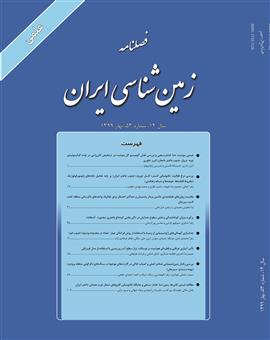بررسي نرخ فعاليت تكتونيكي محدوده گسل دورود(جنوب باختر ايران) بر پايه تحليل دادههاي ژئومورفولوژیک (مخروط افكنهها، حوضهها و شبكه زهكشي)
محورهای موضوعی :
کلید واژه: ژئومورفولوژي نوزمين ساخت مخروطافكنه گسل دورود گسل جوان زاگرس,
چکیده مقاله :
تحلیل مورفوتکتونیکی با کمک شاخصهای ژئومورفیک بهعنوان ابزاري براي مشخص نمودن ساختارهاي جديد و فعال متاثر از حركات تكتونيكي در نواحی ویژه میباشند. این تحلیل در بخشی از محدودهی گسل درود با استفاده از شاخصهایی مانند سينوسي جبههي كوهستان (Smf)، شاخص نسبت پهناي كف دره به ارتفاع آن (Vf)، عامل عدم تقارن حوضه (Af)، گراديان طولي رودخانه (Sl)، عامل تقارن توپوگرافي (T)، سينوسيته رودخانه (S)، عامل شكل حوضه، فرم حوضه، ضريب كشيدگي و نسبت كشيدگي حوضه و شاخص Bs همچنين شاخصهاي در ارتباط با مخروطافكنهها شامل: ميزان خميدگي مخروطافكنه β، ضريب مخروطگرايي و نيمرخهاي طولي، انجام شده است. ابزارهای این پژوهش شامل نقشههاي توپوگرافي، زمينشناسي، تصاوير ماهوارهاي و مدل رقومي ارتفاعي (DEM) و تصاوير سنجنده IRS منطقه و نرمافزارهای Gelobal Mapper و GIS میباشد. نتايج دادههاي حاصل از تحليلهاي توپوگرافي، شواهد زمينريخت ساختي حاصل از مشاهدات ميداني و مقادير بهدست آمده از شاخصهاي ژئومورفيک، همگي نشان از فعال بودن نوزمينساختي منطقه است. محدوده مورد مطالعه براساس طبقهبندي LAT در کلاس يك قرار ميگيرد که نشاندهنده فعاليتهاي زمينساختي شديد است. براساس نتايج بهدست آمده بخش شمالي گسل دورود نسبت به بخش جنوبي از نظر حركات نوزمينساختي فعالتر ميباشد.
Morphotectonic analysis with the help of geomorphic indices is considered as a tool for the identification of new and active structures affected by tectonic movements in special areas. For this purpose, indicators such as Mountain Front Sinuosity index (Smf), (Vf), (Af), (S), (Sl), (T), form factor basin, basin shape, slenderness ratio and stretch ratio index of basin (Bs) associated with alluvial fans, including fan of bending β, fanning coefficient and longitudinal profile were calculated. The tools in this study include: the topographic maps, field geology invesigations, satellite imagery, digital elevation model (DEM), IRS satellite images of the region, GIS and Global mapper softwares. The results of the analysis of topographic data, evidences from field observations and data obtained from geomorphic indicators, all suggested that the area is active from neotectonics viewpoint. Based on the classification of LAT, the study area is classified in class 1, which indicates intense tectonic activity. Based on the results, the northern part of the Dorud fault is more active than the southern section in terms of neotectonic movements.

